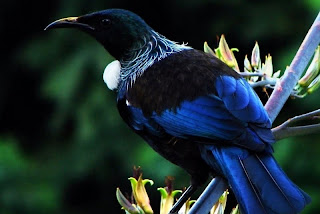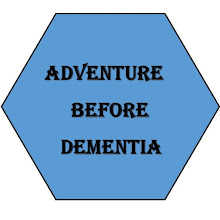We headed out after breakfast to drive cross-country to Rotorua. We picked up the Great Southern Highway, and it wasn't long before we were surrounded by farmland - green, rolling hills - mostly cattle and row crops. This is said to be the best farmland in the country due to the volcanic soil.
We stopped in the town of Hamilton to visit its famous botanical garden. It's big enough to spend a day wandering around, but we spent most of our time looking at the roses, which were in full spectacular bloom.
Just outside of the town of Cambridge, stopped at the organic dairy farm of Ray and Dorothy Higgins, who had invited us all for lunch. Lunch included fresh asparagus soup and all sorts of sandwiches; for dessert we tried cinnamon oysters and fresh strawberries. Yum.
Ray showed us how the farm is laid out, with 150 acres divided into 33 paddocks plus area for the house and barn; they have 150 Jersey cows including 5 bulls. Dorothy showed us around her gardens, which she's been perfecting for 20+ years; the Master Gardener folks would love to give tours here. Then Ray took us to the milking barn to explain how that operation works, with only him and his son to handle the work. All in all, this was a very pleasant stop.
Near the farm, we had a quick look at a kiwi fruit farm. We were surprised to see that it looked just like a grape vineyard - the plant grows on vines. We also learned that the original name of this fruit was 'Chinese gooseberry,' but the New Zealand agriculture folks started calling it kiwi fruit as part of a scheme to market the product on the world market. It seems to have worked pretty well.
We stopped along the way at Zorb Rotorua - to watch the crazies bouncing down the hill. The Zorb is an 11-foot high inflatable transparent sphere, in which there is a smaller sphere for passengers - with about 2 feet of air protecting you from the ground. The grand sport of Zorb riding was invented in New Zealand, but none of our group felt like this was their adventure for the day.
We had been told that we would smell Rotorua before we'd see it. The town lies in the heart of a volcanic plateau and the sulfuric aroma in the air is an unmistakable signal that there are geothermal features in the area. Steam rises out of gutters and along roadsides, geysers spew steam and hot water, pools of mud bubble and boil - volcanic and geothermal activity is everywhere a part of the landscape. Rotorua also is focal point of the Maori culture in New Zealand; Maori make up one-third of the town's population.
As we entered the town of Roturua, we stopped first near Lake Rotorua. We saw the historic Rotorua Bath House (now a museum) and watched the men playing boules (sort of like bocce) on the greens in front of it.
Around Rotorua, there are 11 large lakes formed by past volcanic action, further evidence of the centuries of volcanic action throughout this region. We set out to have a look at a few of them. Our first stop was Lake Tarawera, the largest of the four lakes that surround Mt Tarawera, the volcano which last erupted in 1886. It killed over 150 people and buried a village on the Southwest shore.
On a short walk along the shore, we saw a New Zealand kingfisher and a Tui bird.
We also had our first good look at the New Zealand Silver Fern, the country's national symbol. On top, the leaves look like an ordinary green tree fern. On the bottom, the leaves are a striking silvery-white. We later learned that the Maori used these silver leaves to mark trails that could be followed in the dark.
Next stop was Lake Rotokakahi, known as the Green Lake. Named by the Maori for its abundance of shellfish, it is emerald green in color due to its shallow, sandy bottom. It remains largely undisturbed as it is considered a sacred place by the Maori.
Final stop was Lake Tikitapu, known as the Blue Lake. This lake lies within a volcanic caldera; its blue color is attributed to its depth and the presence of rhyolite and pumice on the lake bed.
On the way back into town we stopped at The Redwoods, a section of the Whakarewarewa Forest planted in Coastal California Redwoods. The larger forest was part of a grand experiment starting back in 1899 when 170 tree species from all over the world were planted here to discover which ones could be grown successfully as timber trees in the central part of the North Island of New Zealand.
While many of the trees did not survive, about 15 acres of redwoods planted in 1901 thrived and today stand over 200 feet high. In their natural habitat their lifespan is 600 years and they can grow as tall as 360 feet. Fortunately for us, the redwood grew too fast to make strong timber, so today it’s just a beautiful forest and provided us a great place for a walk in the woods.
Back at the hotel, we had a chance to appreciate the view from our rooms - overlooking part of the thermal area that characterizes this region. We went to sleep listening to the mud pots bubbling and the geysers spraying and the steam escaping the earth. Definitely one of the more interesting places we've stayed.
Blog Archive
-
▼
2009
(37)
-
▼
October
(37)
- G'day, mates! We’re off on our biggest and longest...
- TWO COUNTRIES A WORLD AWAY ...
- Friday, October 30, 2009
- Saturday, October 31, 2009
- Sunday, November 1, 2009
- Monday, November 2, 2009
- Tuesday, November 3, 2009
- Wednesday, November 4, 2009
- Thursday, November 5, 2009
- Friday, November 6, 2009
- Saturday, November 7, 2009
- Sunday, November 8, 2009
- Monday, November 9, 2009
- Tuesday, November 10, 2009
- Wednesday, November 11, 2009
- Thursday, November 12, 2009
- Friday, November 13, 2009
- Saturday, November 14, 2009
- Sunday, November 15, 2009
- Monday, November 16, 2009
- Tuesday, November 17, 2009
- Wednesday, November 18, 2009
- Thursday, November 19, 2009
- Friday, November 20, 2009
- Saturday, November 21, 2009
- Sunday, November 22, 2009
- Monday, November 23, 2009
- Tuesday, November 24, 2009
- Wednesday, November 25, 2009
- Thursday,November 26, 2009
- Friday, November 27, 2009
- Saturday, November 28, 2009
- Sunday, November 29, 2009
- Monday, November 30, 2009
- Tuesday, December 1, 2009
- Wednesday, December 2, 2009
- Thursday, December 3, 2009
-
▼
October
(37)

















